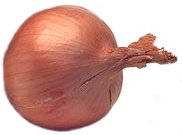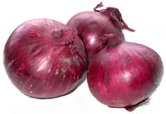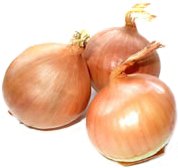

Onion

Allium cepa. Liliaceae (Alliaceae). The onion is a biennial grown as an annual for the edible bulb, which has a usually strong pungent flavour. The leaves and immature bulbs are also edible. The onion probably originated in the regions of Iran and western Pakistan. It no longer occurs in the wild, although there are other members of the genus having a similar form and flavour which are native to more northern temperate regions. Its use can be traced back to 3200 BC, when it was an important food crop for the Egyptians. Onion production in India dates back to about 600 BC and there are records of the crop’s use by Greeks and Romans about 400-300 BC. By the early Middle Ages, onions had reached northern Europe. Today the onion is cultivated on a large scale throughout most temperate and tropical regions of the world. The onion is best adapted to a Mediterranean-type climate where the hot dry summers are ideal for bulb maturation. However, there are a large number of cultivars suited to a range of growing conditions, including cool-season production in tropical regions. For high yields, however, cool weather is desirable during the early stages of growth. The crop is tolerant of frost, but prolonged exposure to temperatures below 10ºC will vernalise plants and cause them to bolt. Optimum seedling growth occurs in the range 20-25ºC and declines rapidly at temperatures above 27ºC. Once young plants are large enough, bulb formation is able to take place in response to long-day conditions. For this reason most cultivars grown in temperate climates will bulb during early summer, producing a late summer harvest. However, cultivars have been selected to produce bulbs over a wide range of long-day conditions ranging from 12 to more than 16 hours, thus making it posssible to manipulate crop development in different regions. In all instances the bulbing response is to long days, although the cultivars sensitive to the lower end of the range are often erroneously referred to as short-day selections. Bulbing is also advanced to some extent by higher temperatures and also nitrogen deficiency. As leaves die back, the bulb enters a period of dormancy which can be prolonged by storing under conditions of low temperature (1ºC) and low relative humidity. Using an appropriate choice of cultivars along with storage, onions can be available from summer through winter until the following spring. Immature salad onions can be harvested throughout most of the year. Onions can be served cooked to provide flavour in a wide range of dishes or in soups. Salad onions trimmed and served entire, sliced bulbs and leaves are all served raw in salads. Small onions are use for pickling. Onions require an open site and a fertile well-drained soil. Soil pH should be at least 6.5 and more acid soils will require liming. Well-rotted organic matter will help improve the moisture retention characteristics of the soil. Onions are susceptible to a number of soil-borne pest and disease problems and for this reason a long period (at least four years) is desirable between successive crops to prevent their build-up. 
Bulb onions can either be propagated from seed or vegetatively, using small bulblets referred to as sets. Maincrop onions should be sown in a well-prepared seedbed during early spring. Germination is poor in cold wet soils and, where possible, cloches should be used to warm the soil for early sowings in cold areas. Seed, preferably treated with a fungicidal dressing, should be sown thinnly in 2cm deep drills in rows 30cm apart. Once established, the within-row spacing can be adjusted to 4cm between plants by thinning. The size of the bulbs at harvest time is strongly influenced by competition between neighbouring plants and if larger bulbs are required the withing-row spacing should be increased to up to 10cm. Similarly, where small bulbs are required for pickling, plant populations can be arranged to give approximately 300 plants per square metre. Weed control is important, particularly during the early stages of growth when the crop is building up its leaf area. During dry weather additional water may be necessary, but should not be applied too late during the development as it may delay maturity and impair the keeping quality of bulbs. Onions are ready to harvest when the leaves start to die back and fall over. They should be lifted at this stage and dried and cleaned thouroughly if required for storage. They may either be tied in ropes and hung up after drying in a cool dark shed or, alternatively, stored in net bags or shallow trays. Damaged and thick-necked bulbs do not store well. The cultivation of an autumn-sown crop is more difficult. A suitable hardy cultivar should be selected which is capable or earlier bulbing the following year. The sowing date is also critical and depends on local climatic conditions. If plants are sown too early they may become large enough to be vernalised by the low winter temperatures, which will cause them to bolt in spring. Conversely, if sown too late they may be too small to survive the winter. As a rough guide the sowing date should be adjusted to enable the seedlings to reach a height of 15-20cm before the onset of winter. 
The simplest technique for onion raising is to use sets. They are less prone to disease, will give a reasonable crop even in poor soil conditions, and mature earlier than seeded crops. Cultivars are available for both spring and autumn planting. They should be planted firmly with their tips at soil level 5cm apart in rows spaced at 25cm apart. If extra-large bulbs are required these spacings should be increased. For salad use it is possible to use the thinnings removed during the production of maincrop onions. For continuity of production it is, however, preferable to sow specific cultivars (usually referred to as spring onions or scallions in the US) from spring to mid-summer at intervals of two to three weeks. These can be followed by over-wintering sowings of extra-hardy cultivars for harvesting in the spring. In cold areas the overwintered crop is nest protected by cloches. Salad onions should be sown at a fairly high density of around 300 plants per square metre, either in rows spaced at 10cm apart or in bands 8cm wide with 15cm between bands. Thinning should not be necessary and onions can be harvested by pulling as required. Onion cultivars are available for a wide range of environmental conditions and uses. Most are brown-skinned or yellow-skinned but red cultivars are also available. In cool climates, spring and autumn sowing are practised, though many cultivars can be sown at either time. In warm climates the equivalent criterion is long-day or short-day cultivars depending on locality. Recommended spring-sown cultivars: ‘Ailsa Craig’ (large, consistent, long-keeping, a standard exhibition cultivar), ‘Bedfordshire Champion’, (large, globe-shaped, long-keeping, exhibition standard), ‘Caribo’ (straw-coloured), ‘Early Yellow Globe’ (mild, stores well), ‘Hygro’ (vigorous, globe-shaped), ‘Lancastrian’ (globe-shaped), ‘North Holland Blood Red’, ‘Red Baron’, ‘Red Torpedo’, ‘Rijnsburger-Balstora’ (dark thin skin), ‘Rijnsburger-Robusta’ (dark straw-coloured), ‘Ringmaster’ (very large, mild, good for onion rings), ‘Southport Red Globe’ (purple-red, globe-shaped, ‘Southport White Globe’ (pure white, globe-shaped), ‘Sweet Sandwich’ (light brown, globe-shaped, sweet pale yellow flesh), ‘White Sweet Spanish’ (white, globe-shaped, mild, also used for bunching), ‘White Sweet Spanish Jumbo’ (very large), ‘Yellow Bermuda’ (pale straw colour, mild and sweet). For autumn sowing: ‘Buffalo’ (globe-shaped, high-yielding), ‘Burgundy’ large flattened globe, dark red), ‘Express Yellow’ (globe-shaped), ‘Keepwell’ (globe-shaped, dark straw colour), ‘Imai Early Yellow’ (globe-shaped), ‘Senshyu Semi-Globe Yellow’ (high yield), ‘Sturon (flattened bulbs, good yield, long keeper), ‘Texas Supersweet’ (very large and sweet), ‘Vidalia’ (large, yellow, globe-shaped, very sweet), ‘Walla Walla Sweet’ (large, globe-shaped, brown, possibly the sweetest onion), ‘White Burmuda’ (semi-flat, white, very mild), ‘White Granex’ (large, flat, white, mild), ‘Yellow Granex’ (large, flat, pale yellow, very mild). 
For salad onions the main cultivar is ‘White Lisbon’; ‘Winter Hardy White Lisbon’ is a frost resistant selection. Although less winter hardy, the bunching onion (Allium fistulosum) is an attractive and more pungent alternative to the salad onion. Available cultivars include: ‘Yoshima’, ‘Hikari Bunching’, ‘Ishikura’, ‘Nebuka’ and ‘Hardy Long white’. Pearl or pickling onions, also called baby onions or boilers, are harvested when very small. Most are white-skinned; these include ‘Aviv’ (almost round), ‘Barletta’ (nearly round, used as cocktail onion), ‘Crystal Wax’ (flattened, very mild, ‘Paris Silverskin’ (flat), ‘Purplette’ (purple-red), and ‘Wonder of Pompeii’ (silvery). The Egyptian onion (Allium cepa variety aggregatum) produces small elongated bulbs in place of flowers on 1m tall stems. These can be harvested and planted in summer when they are ready for use during the following year. Their culinary uses are similar to those of ordinary onions. Leaf blotch, caused by the fungus Cladosporium allicepae, results in eye-shaped, white lesions, the centres of which become brown when spores are produced. If the infection is widespread the numerous white lesions resemble damage caused by droplets of a herbicide such as paraquat. Leaf rot, caused by Botrytis squamosa, also produces white lesions on the leaves and these tend to be concentrated around the tips, resulting in dieback. Under moist conditions a grey mould growth develops on the shrivelled tissue. Another Botrytis species, Botrytis cinerea, invades seedlings soon after emergence and susequently causes a collar rot. Fungicide sprays may be necessary to control the leaf blotch, leaf rot and collar rot diseases. Smut, Urocystis cepulae, is soil borne and the mycelium from germinating spores infects young seedlings. The first symptoms are lead-coloured streaks and spots; eventually the leaves become swollen and distorted and split to expose black, powdery spore masses. The spores can survive in the soil for up to 20 years so it is important not to grow Allium species on contaminated land although soil fumigation and fungicide seed treatments may give some control. White rot, caused by Sclerotium cepivorum, is another soil-borne disease. Affected plants are stunted and yellow, and black sclerotia form amongst the white fungal growth which rots the base of the plant. The sclerotia are resting bodies which persist in the soil. Mercurous chloride, calomel, applied in the drill or as a seed dressing, is the traditional control measure for this disease. Shanking is the name given to the disease caused by Phytophthora subspecies. These soil-borne fungi attack the roots and bulbs so that the leaves turn yellow and shrivel. There are no specific control measures but crop rotation should help. 
Onions can also be affected by downy mildew (Peronospora destructor) and storage rots caused by bacteria (Erwinia carotovora) and fungi (Botrytis allii, the cause of neck rot, Aspergillus and Penicillium subspecies). The aphid-transmitted onion yellow dwarf virus results in small bulbs and yellow, distorted leaves; onions are less frequently affected than shallots and leeks. Diseased plants should be destroyed and if possible, certified virus-free sets should be used. The diseases referred to above affect, to the same extent, other Allium subspecies including chives, garlic, shallots and the ornamentals.
|
Home
Grow Nuts
Grow Herbs
Grow Fruit
Cyberian Index
If you like this website and want one of your own contact
Cyberian All information correct at
time of publication and open to updates as necessary. No part of this website,
or its vectors, may be produced in any shape or form, using any type or design
of medium, system, equipment or otherwise without the prior written consensual
notice of the Cyberian. Any breach of these requirements will result in the
appropriate action. If in doubt, e-mail contact is recommended.
Some components of this website were obtained as open-source software and are
used in the same non-profit manner on this website.